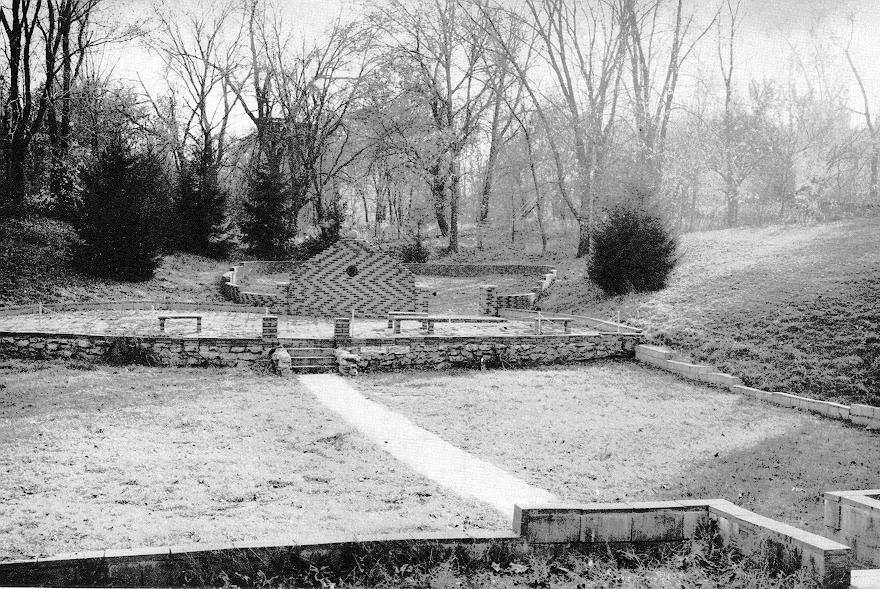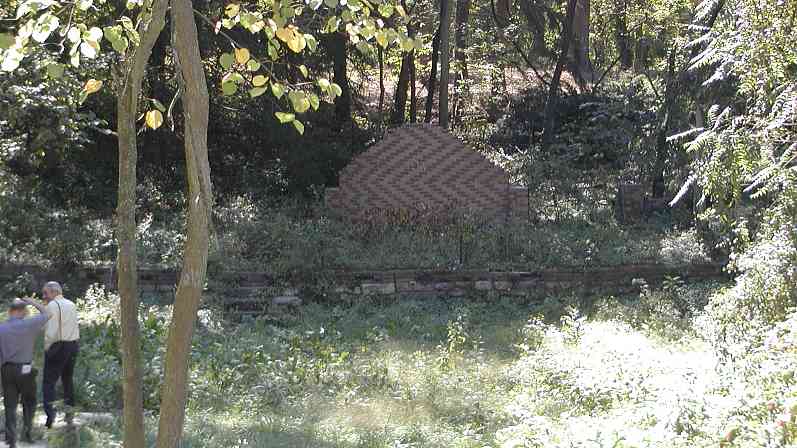Western Military Academy
 In 1879 Edward Wyman
LL.D., a leading St. Louis educator, opened a home school for boys under the
name of Wyman Institute. When Wyman died in 1888, one of his assistants, Albert
M. Jackson, took over. The school was transformed into a military academy in
1892. Col. Jackson and Maj. Eaton assumed ownership in 1896. Many of the
surviving military academy high schools
were established around this time.
In 1879 Edward Wyman
LL.D., a leading St. Louis educator, opened a home school for boys under the
name of Wyman Institute. When Wyman died in 1888, one of his assistants, Albert
M. Jackson, took over. The school was transformed into a military academy in
1892. Col. Jackson and Maj. Eaton assumed ownership in 1896. Many of the
surviving military academy high schools
were established around this time.
The two principal buildings burned down in February of 1903. The corps of cadets was dismissed and reconstruction began. With three buildings complete, WMA resumed operations that fall with 115 cadets. Enlargements and improvements in 1912 and 1913 increased the capacity to 200 cadets. Enrollment peaked at 330 cadets in the early 60's.
Western was a family affair. Col. A. M. Jackson, one of WMA's
founders, was the first superintendent, followed by his son, Col. R. L. Jackson.
His grandson, Col. Ralph B. Jackson, WMA '35, became superintendent in 1953.
By 1962 some of the Class of '62 sensed a decline. We did not sense a core of
cherished traditions. The reverence depicted in the movie Taps was
absent. We were not taught school songs. The exploits of past graduates were
rarely honored in public. The comfort of a strong authority structure noticeably
weakened as Western eased into the Sixties.
Considering the current problems at The Citadel and VMI, it is worth noting
that Western once had a coed, a day student (one who lived at home and commuted
to school). Unlike VMI and The Citadel, Western did not have rigorous physical
admissions standards and training when I was a student (after all, they let me
in). The main problem in making Western coed would have been the time required
to build coed enrollment up to a critical mass. As it was, Western's maximum
enrollment of 330 was not large enough to allow the variety of courses needed to
support students with diverse educational requirements. Of the remaining
military academies, most are no larger than Western was, but their students'
academic requirements may be more homogeneous.
There is general agreement that the declining allure of the military (the
Army in particular) did not help Western's fortunes. Some think the school did
not adapt fast or well enough to the changing times. Perhaps the school changed
too much; the surviving military high schools seem to advertise a more austere
lifestyle than what I experienced at WMA. Perhaps the academic curriculum was an
issue. Some high schools offered forensics, French, Russian, and Calculus, which
Western did not.
Monticello College, a private girls' school 4 miles distant, also went out of
business during those lean years. The Monticello plant now supports a community
college. (An aerial photo is near the bottom of this page.)
The buildings on the left are the cadet Barracks A to E, each
with three floors and basement. E Barracks was the primary "new man" barracks.
The "A Barracks fourth floor" was actually the West wing of the third floor.
Col. Persing's quarters P were in the first two floors of the West wing
of A Barracks. When an important event came up, Col. Persing would sometimes pay
a cadet in A Barracks to polish his shoes.
The Quartermaster's office, mail room, and a few classrooms were located in
the small building Q behind A Barracks. The flag pole is seen in front of
A Barracks.
Col. Jackson's quarters were in the right half of the square part of the
Administration building. The left half of the west wing housed the business
offices and the infirmary. The library and study hall took up the second floor
of the East wing. In Western's early years, every cadet had his own desk in the
study hall. The kitchen and mess hall occupied the first floor, which is
partially below grade. The third floor housed classrooms.
The two gymnasia appear at the right of the picture. The Chapel was just past
the lower gymnasium. The Chapel was equipped with a pair of carbon-arc sound
movie projectors.
Some parts of Western were built after this picture was taken. F
Barracks and the Canteen were in a wooden building located past the chapel,
where the WMAS signal was weak. The Senior Circle would have been near the lower
right of the picture. The Commandant's Office o was added to the SW
corner of C Barracks. Col. Moore's quarters M were in the SE corner of C
barracks. The WMAS studios w were in the basement of D barracks facing C
barracks and Col. Moore's quarters.
Below: Front view of A-E barracks and the Commandant's Office, ca. 1962.
C barracks is the sole survivor as of October 2002. East wing of the Administration building, ca. 1961. The Mess Hall was on the
first floor, with the kitchen under the adjoining west wing. The third floor
housed classrooms. The second floor was used for study hall and library. During
the 1960-61 school year two cadets lived in the room above the door at the right
of the picture. Col. Persing's office was on the second floor, just to the left
of that door. This was too much to
resist.
Below: Admin building in 2002, minus Ivy. The faculty mailboxes haven't changed at all. Below: aerial photo looking towards the West, 1965 Recall. Belt buckle used with Cadet Officers' Mess Jacket and Dress Suit. Life at Western changed considerably over the years with a gradual shift from
a Spartan life to a kinder, gentler routine. By the time I arrived at Western in
1959 the military spirituality seen in the movie Taps was mostly
relegated to pictures on the library walls and dedications of the chapel's
stained glass windows (see below). The military model was used to organize and
administer the cadets' daily lives.
Daily life was controlled by a school wide bell system operated by an IBM
clock next to Col. Persing's office. About 1961 the school replaced the clock
with a new model and I ended up with the old clock in its beautiful wooden case.
This made the ultimate alarm clock which I set to go off just before the
breakfast mess call, maximizing my morning sleep. At the time I did not
understand that certain switches require a minimum current to work reliably, and
I discarded the clock after the switching became unreliable.
Except for Sunday breakfast and inclement weather, we formed up in companies
in front of the barracks and marched to our meals. We stayed in formation until
we passed through the mess hall doors, after which we proceeded to our assigned
seats. We stood at attention behind our seats. On command, we sat down, still at
attention with our arms held out in front with forearms folded. Then were we
commanded to relax. When the meal was finished, we came to attention, rose, and
were dismissed.
One winter the sidewalks were frozen over for several weeks, so we couldn't
march into mess. It was hard to believe we missed marching to mess, but we did.
Weekday classes ran from 0800 to mid afternoon with time out to march to
lunch. The high school students received either a college prep or business
administration curriculum. Each junior and senior gave a short prepared speech
to the entire cadet core. Each senior gave an hour long report on a chosen
literary figure to his English class.
Afternoons were free for sports, honor guard drill, and hobbies. Then we
marched to dinner. The time between dinner and study hall (in the cadets' rooms)
at 2000 was used for calling girl friends, writing home, and listening to the
radio. A few cadets listened to WMAS.
Saturday morning was spent preparing for inspection, followed by drill
practice and the rare 5 mile hike. Saturday afternoon could be spent off campus
at the Uptown Theatre ("finger bowl") or other hangouts. Saturday evening
usually saw a movie, dance, or play.
Breakfast was optional Sunday morning. Unless you had a waiver from your
parents, you had to go to church, synagogue, or Sunday school. I changed from
Methodist to Baptist because I preferred Sunday school with local girls to a two
mile march to church. Early Sunday afternoon was free time off campus until time
for the Sunday afternoon parade. Sunday evening was a school night.
During my freshman year there was some intimidation and a wee bit of light
hazing (e.g., a whack in the belly from a cleaning rod handle). Paradoxically,
dropouts increased in later years as discipline was relaxed.
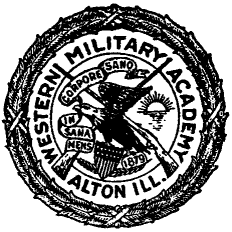 Western
graduated its last class in 1971 and went out of business. The campus was mostly
idle for a decade. Neglect and vandalism took their toll. In 1974 the
Mississippi Valley Christian Academy, a tax exempt school, bought the remains of
the Western plant. They now operate a K-8 coed day school.
Western
graduated its last class in 1971 and went out of business. The campus was mostly
idle for a decade. Neglect and vandalism took their toll. In 1974 the
Mississippi Valley Christian Academy, a tax exempt school, bought the remains of
the Western plant. They now operate a K-8 coed day school.
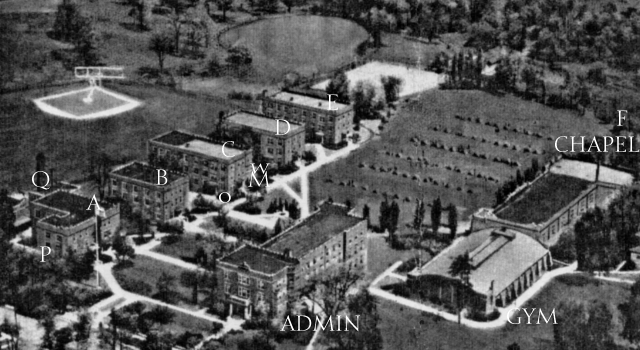
Aerial view from the
1930's or 40's, probably a copy of a postcard. During this author's four years
at Western (58-62) there were no bivouacs like the one shown in this picture.
Each new cadet was issued a rifle or carbine (minus firing pin) but not a tent.
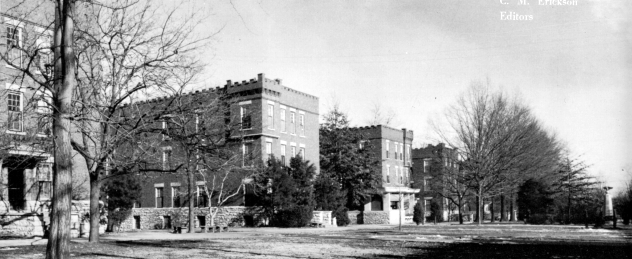
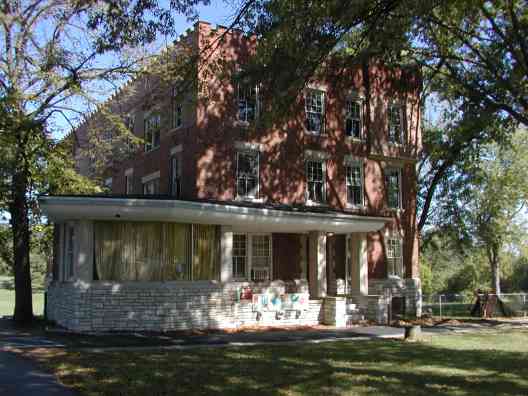 Note the stylistic clash between the Commandant's Office and the
rest of the campus.
Note the stylistic clash between the Commandant's Office and the
rest of the campus.
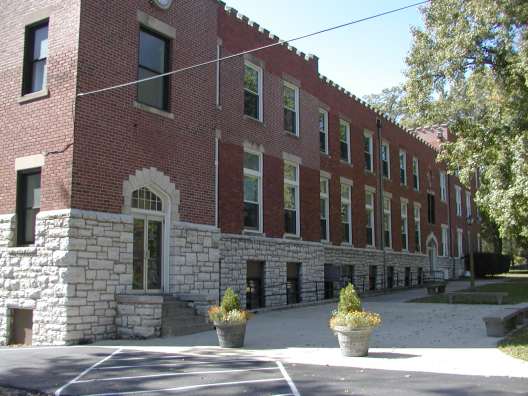
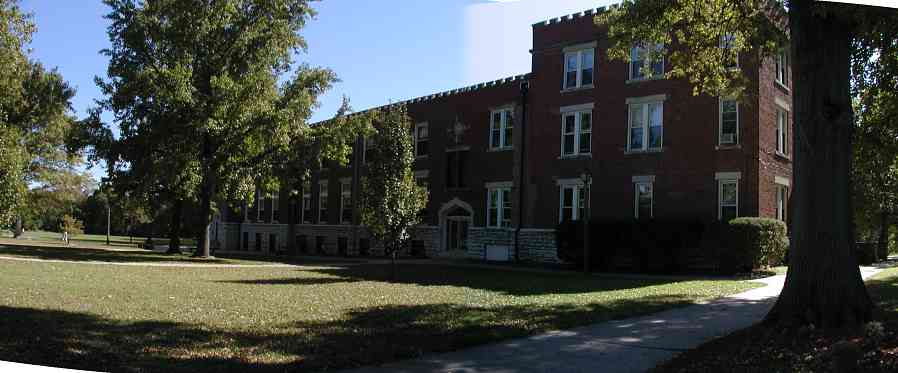
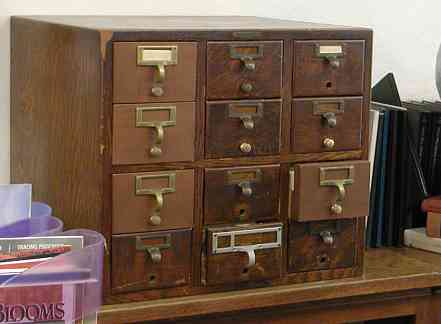 Left: The card catalog
looks about the same in 2002. But don't expect to find Chaucer in it. (Chaucer
may not be appropriate for grade school.)
Left: The card catalog
looks about the same in 2002. But don't expect to find Chaucer in it. (Chaucer
may not be appropriate for grade school.)
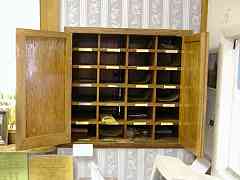
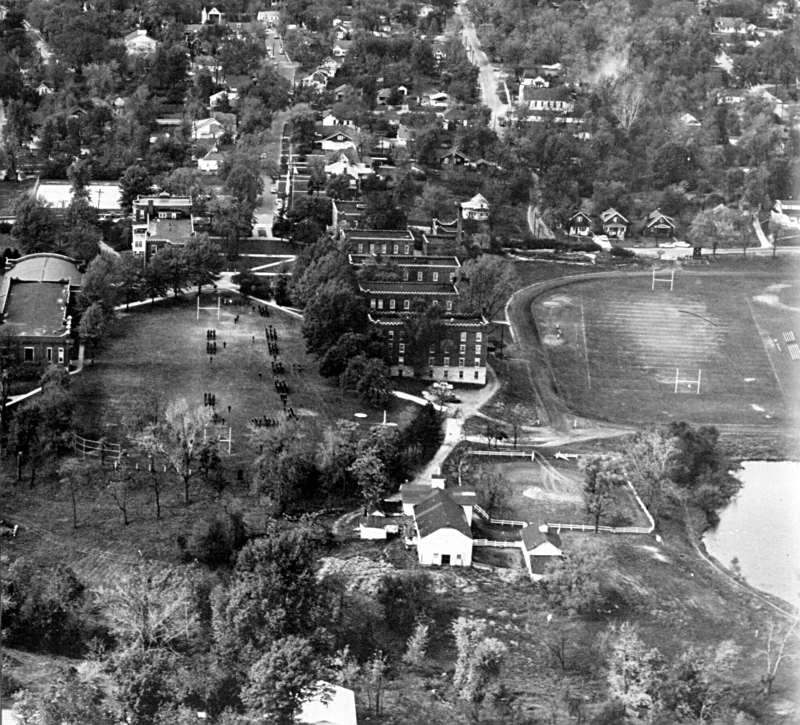
 All that remains of the Upper
Gym in 2002.
All that remains of the Upper
Gym in 2002.
Life at Western Military Academy
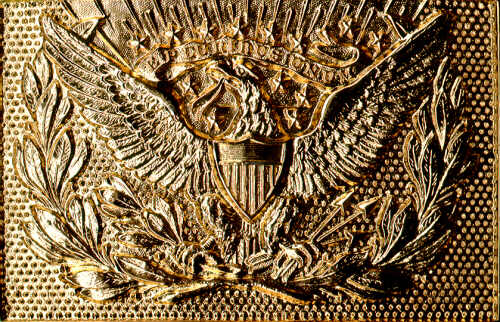
The Stained Glass Windows
 The Sir Galahad panel was
presented by Col. R. L. Jackson. The panel is dedicated to his nephews, Captain
Rex K. Latham Jr, Lieutenant A. J. Ellison, and Lieutenant James K. Latham, who
made the supreme sacrifice in World War II. The panel is an idealistic treatment
portraying Tennyson's mythical character -- Sir Galahad. This version of the
picture was set in antique glass by Emil Frei, St Louis.
The Sir Galahad panel was
presented by Col. R. L. Jackson. The panel is dedicated to his nephews, Captain
Rex K. Latham Jr, Lieutenant A. J. Ellison, and Lieutenant James K. Latham, who
made the supreme sacrifice in World War II. The panel is an idealistic treatment
portraying Tennyson's mythical character -- Sir Galahad. This version of the
picture was set in antique glass by Emil Frei, St Louis. 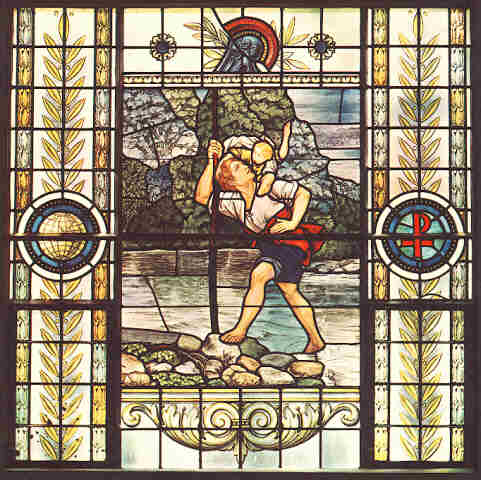
The St. Christopher panel was the
central figure in the series of antique glass reproductions of famous figures in
the Cadet Chapel. The original window of St. Christopher be Adam Elsheimer
(1578-1610) was reproduced in antique glass by Emil Frei of St. Louis. St.
Christopher is often referred to as the "Soldier's Guardian Saint".
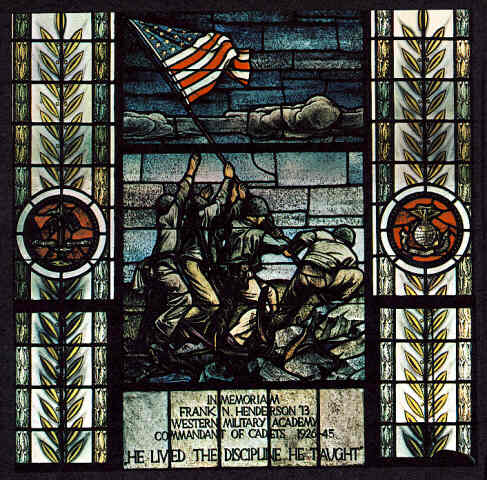 The Iwo Jima
panel in the Western Military Memorial Chapel was dedicated to Frank M.
Henderson, WMA'13, who retired as Commandant of Cadets in 1945. The central
panel commemorates the spirit of the United States Marines in the battle of Iwo
Jima on Mount Suribachi, Feb 23 1945, in the Pacific theatre of World War II.
The Iwo Jima
panel in the Western Military Memorial Chapel was dedicated to Frank M.
Henderson, WMA'13, who retired as Commandant of Cadets in 1945. The central
panel commemorates the spirit of the United States Marines in the battle of Iwo
Jima on Mount Suribachi, Feb 23 1945, in the Pacific theatre of World War II.
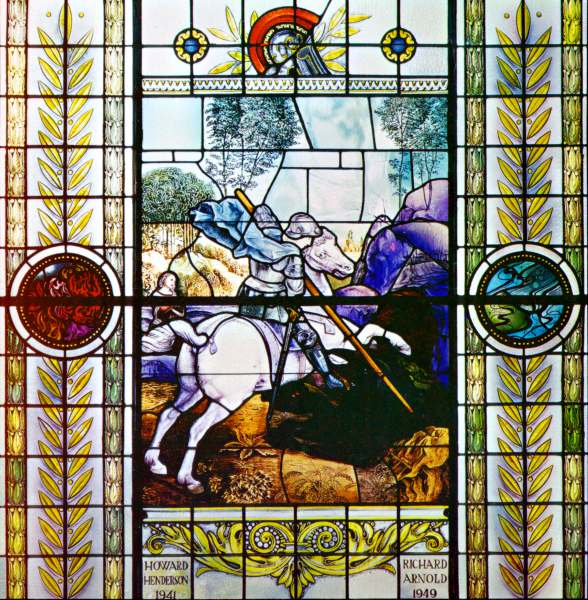 The
St. George window was presented by Dr. and Mrs. R. H. Henderson of Glenview Il,
and by Dr. R. J. Arnold of St. Louis in memory of their sons.
The
St. George window was presented by Dr. and Mrs. R. H. Henderson of Glenview Il,
and by Dr. R. J. Arnold of St. Louis in memory of their sons.
Howard Swain Henderson, '41, was killed while a member of the Air Corps in a training accident over Ellington Field, Texas, April 1, 1944. Richard Lee Arnold, '49, lost his life on August 29, 1948, in a plane accident near St. Louis soon after he had received his pilot's license and just before he he was to return to Western for his senior year.
The Memorial Window is a reproduction of Raphael's famous painting, "Sir
George and the Dragon", depicting youthful chivalry vanquishing the forces of
evil.
The Senior Circle
Upper Alton
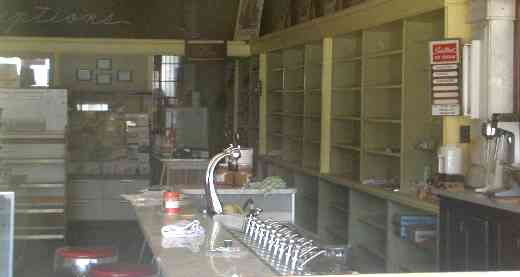 Almost none of the Upper Alton we knew is recognizable any more.
Almost none of the Upper Alton we knew is recognizable any more.
Left: Kerr's Pharmacy and soda fountain, October 2002. 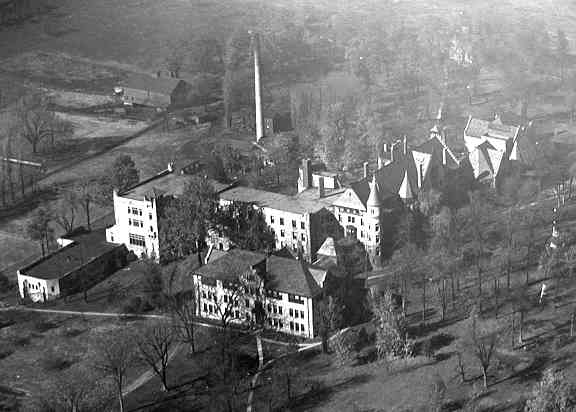 Left: Monticello, a girls'
school about 4 miles from Western. Photo is on display at the Alton Museum.
Left: Monticello, a girls'
school about 4 miles from Western. Photo is on display at the Alton Museum.
The stained glass windows and the black and white pictures were scanned from editions of the Recall and other archives. The color pictures were taken October 5 2002.
The Solid Class of '62
WMAS and Radio Free Moscow
For replacement WMA class rings contact Dick Wood '57 BALSALINC@aol.com
For further information and alumni news, please support the
Western Military Academy
Alumni Newsletter $10/yr
Editor, Robert
Keith '36 robkeith36@mindspring.com
7880 54th Av #65
St. Petersburg FL
33709
Raw Pictures WMA
Web-Counter
says that you are visitor number

